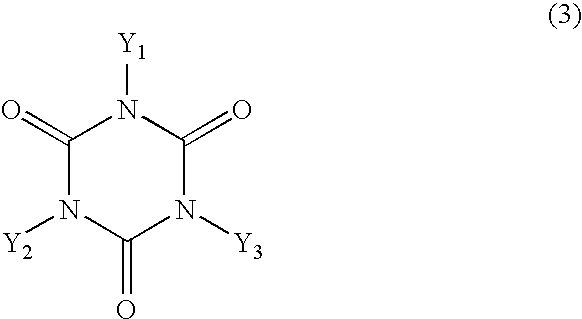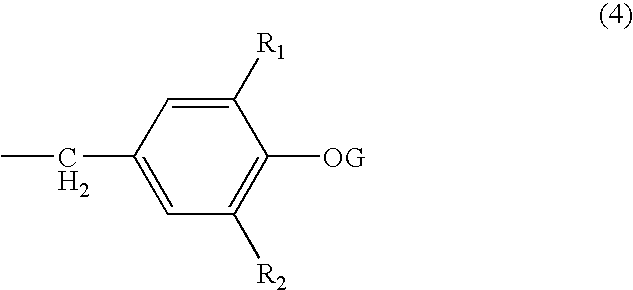Epoxy resins, process for preparation thereof, epoxy resin compositions and cured articles
- Summary
- Abstract
- Description
- Claims
- Application Information
AI Technical Summary
Problems solved by technology
Method used
Image
Examples
synthesis example 1
Synthesis of Hydroxy Compound
[0041] In a 2-L four-necked flask were placed 201.3 g of 2,6-xylenol, 67.7 g of cyanuric acid, 62.0 g of 92% paraformaldehyde, 1.76 g of hexamethylenetetramine, 584 g of dimethylformamide and 15.75 g of pure water and the mixture was allowed to react under reflux at approximately 116.degree. C. for 40 hours in a stream of nitrogen. After the reaction was over, the reaction mixture was cooled with stirring to approximately 5.degree. C. to precipitate crystals and the crystals were filtered, washed with methanol and dried under reduced pressure to give 235 g of a hydroxy compound in white powder. The melting point of the compound was 247-248.3.degree. C.
[0042] The GPC chart of the hydroxy compound is shown in FIG. 1 and the infrared absorption spectrum in FIG. 2. The data read off the FD-MS chart and the analysis of H-NMR spectrometry conducted in acetone-d6 are given below.
[0043] FD-MS (m / z: peak intensity)
[0044] 226:9.5, 398:9.8, 532:100
[0045] H-NMR [6 (...
example 1
Synthesis of Epoxy Resin
[0049] In 700 g of epichlorohydrin was dissolved 100 g of the hydroxy compound obtained in Synthesis Example 1 and to the resulting solution was added 37.5 g of a 48% aqueous solution of sodium hydroxide in drops at 70.degree. C. under a reduced pressure (approximately 150 mmHg) over a period of 3.5 hours. During this period, the water formed was taken out of the system together with a part of the epichlorohydrin by azeotropic distillation and the distilled epichlorohydrin was returned to the system. Upon completion of the addition in drops of the aqueous sodium hydroxide, the reaction was continued for another 30 minutes. Thereafter, the salt formed was filtered off, the reaction mixture was washed further with water and stripped of the epichlorohydrin by distillation to give 124 g of an epoxy resin with a softening point of 81.degree. C., a melt viscosity at 150.degree. C. of 0.6 Pa.multidot.s and an epoxy equivalent of 282 g / eq.
[0050] The GPC chart of the ...
synthesis example 2
Synthesis of Hydroxy Compound
[0057] In a 2-L four-necked flask were placed 67.7 g of cyanuric acid, 600 g of phenol, 62.0 g of 92% paraformaldehyde, 0.9 g of hexamethylenetetramine, 580 mL of dimethylformamide and 15 mL of pure water and the mixture was allowed to react with stirring under reflux at approximately 116.degree. C. for 20 hours in a stream of nitrogen. After the reaction was over, the reaction mixture was stripped of the dimethylformamide and the unreacted phenol by distillation under reduced pressure at 200.degree. C. to give 202 g of a brown hydroxy compound with a hydroxyl equivalent of 171 g / eq. and a softening point of 145.degree. C. The data read off the FD-MS chart are as follows.
[0058] FD-MS (m / z: peak intensity)
[0059] 71:26, 107:41, 150:60, 200:28, 235:26, 311:31, 341:38, 447:100, 553:73, 589:14, 766:8
[0060] The FD-MS measurement confirmed the formation of Compound 4 (m / z=235) which is the reaction product at the cyanuric acid to phenol ratio of 1:1, Compound 5...
PUM
| Property | Measurement | Unit |
|---|---|---|
| Temperature | aaaaa | aaaaa |
| Fraction | aaaaa | aaaaa |
| Length | aaaaa | aaaaa |
Abstract
Description
Claims
Application Information
 Login to View More
Login to View More - R&D Engineer
- R&D Manager
- IP Professional
- Industry Leading Data Capabilities
- Powerful AI technology
- Patent DNA Extraction
Browse by: Latest US Patents, China's latest patents, Technical Efficacy Thesaurus, Application Domain, Technology Topic, Popular Technical Reports.
© 2024 PatSnap. All rights reserved.Legal|Privacy policy|Modern Slavery Act Transparency Statement|Sitemap|About US| Contact US: help@patsnap.com










